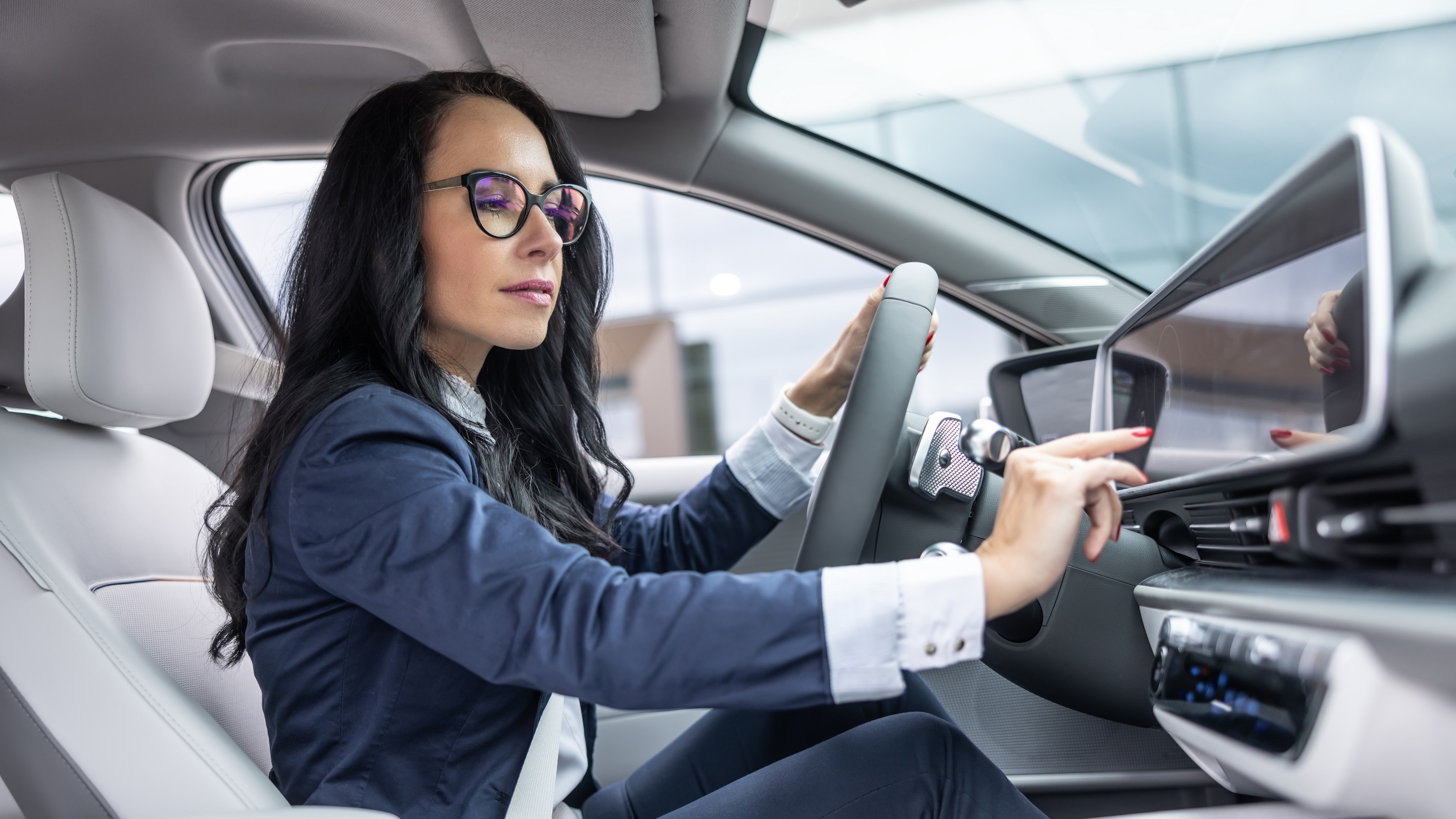If Cars With Touchscreens Are Unsafe at Any Speed, Why Do We Have Them?
Studies show how distracting car touchscreens can be, yet many automakers still use them, perhaps because they’re cheaper to upgrade than physical components.


With homage to Ralph Nader, author of Unsafe at Any Speed, a landmark in consumer advocacy and journalism, today’s story looks at just how little the major auto manufacturers care about safety by forcing us to take our eyes off the road to navigate often confusing touchscreens and turning us into distracted drivers.
While most people think of Tesla as the first automobile with all functions contained in a 17-inch touchscreen, first place actually goes to the 1986 Buick Riviera with its Graphic Control Center for climate control, radio, graphic equalizer, trip calculations, gauges and vehicle diagnostic information. It is “a bad joke,” automotive journalist Brock Yates wrote in September 1986. It “does nothing that a conventional array of knobs, buttons and analog instruments could not do in a fraction of the time.”
Buick dropped it three years later.
From just $107.88 $24.99 for Kiplinger Personal Finance
Become a smarter, better informed investor. Subscribe from just $107.88 $24.99, plus get up to 4 Special Issues

Sign up for Kiplinger’s Free Newsletters
Profit and prosper with the best of expert advice on investing, taxes, retirement, personal finance and more - straight to your e-mail.
Profit and prosper with the best of expert advice - straight to your e-mail.
Studies confirm touchscreens are more distracting than buttons
Studies in the U.S. and Europe demonstrate just how dangerous touchscreens are. In 2022, the Swedish auto magazine Vi Bilägare proved that physical buttons are safer than touchscreens, having tested a dozen vehicles at highway speed — primarily new but also a 2005 Volvo — to see how long it took to perform four simple tasks.
It took 10 seconds in the older car and up to 23.5 in the Tesla Model 3, which traveled more than 2,000 feet with the driver’s eyes off the road. And the Tesla wasn’t the worst performer.
As today’s cars have much larger and more complex touchscreens than just two years ago, few will deny they are distractions on wheels, much like texting while driving.
Studies show that with a driver’s eyes off the road for as little as five seconds, such as while reading a text, a car traveling at 55 mph will go a distance equal to the length of a football field — and it’s like driving that distance with closed eyes.
Sending a text results in 400% more time (20 seconds) with a driver’s eyes off the road, dramatically increasing the chances of an accident.
So, just compare that to fiddling with a touchscreen while on the highway.
Automakers love touchscreens, and they save money
I discussed these issues with Maddie McCarty, PhD, a human factors engineer (ergonomics) at Consumer Reports magazine. “Our research shows that it is easier and safer to use manual controls than a touchscreen to adjust your radio, volume, A/C, without even looking,” she said. “With a touchscreen, you have to look, taking your eyes off the roadway. This is distracting and dangerous,” she pointed out, adding, “People want those buttons and knobs back because they realize it is difficult to use a touchscreen to complete even the simplest task.”
She noted, “Automakers have gone to touchscreens (because they keep costs) down — new features can be programmed over the air without having to produce new physical components. Also, people like shiny new toys, but once they are experiencing glitches, lags and can’t find what they are looking for quickly, then reality sets in that touchscreens are difficult to use. I hope we are at this shifting point where manufacturers are starting to listen to their customers who want those dials, knobs and physical buttons back.”
Obviously, manufacturers aren’t blind, I mentioned. They read the studies and yet are putting out into the market inherently dangerous vehicles. How can this be permitted?
She replied, “The problem is that the government does not regulate the design of these technologies, so car manufacturers can put whatever they want into vehicles, and there is no incentive to take them out. That’s why it is so important for organizations like Consumer Reports to step in and advocate for auto buyers so that safer vehicles will be designed going forward.”
Distraction-caused auto accident lawsuit?
One way of forcing automakers to give more thought to designing safer vehicles is by hitting them in the pocketbook. I ran these issues by Charleston, S.C., personal injury attorney Steven Goldberg of the Steinberg Law Firm, who said, “Manufacturers will be included as co-defendants in personal injury lawsuits stemming from distracted driving accidents caused by touchscreen usage. This is due to their knowing design of vehicles with inherently unsafe touchscreen features.”
He added, “Drivers can access buttons and knobs without taking their eyes off the road. That’s known as ‘muscle memory,’ as instinctively your hand goes to the right place. A touchscreen takes all your attention off driving and is, by definition, an accident waiting to happen.”
And let’s not forget possibly higher auto insurance premiums
By owning a vehicle that has these attention-stealing touchscreens, could your auto insurance rates go up?
I discussed this with Los Angeles-based Karl Susman, an insurance broker for over 30 years and an expert witness in lawsuits involving coverage and agent malpractice issues. He is host of the highly informative talk radio show Insurance Hour.
“The insurance industry is aware of the effects of these screens,” he said, “and has data to support an increased frequency of accidents. Is the handwriting on the wall? We will have to wait and see. Safety in cars should always be the priority.”
Dennis Beaver practices law in Bakersfield, Calif., and welcomes comments and questions from readers, which may be faxed to (661) 323-7993, or e-mailed to Lagombeaver1@gmail.com. And be sure to visit dennisbeaver.com.
Related Content
- Car Insurance Costs Skyrocket in 2024
- Where You Live Has a Huge Effect on Car Insurance
- Employee Refuses to Wear a Motorcycle Helmet: Can He Be Fired?
- What Lawyers Often Fail to Tell Clients About Litigation
- How Far Should a Lawyer Go to Honor His Duty to a Client?
Profit and prosper with the best of Kiplinger's advice on investing, taxes, retirement, personal finance and much more. Delivered daily. Enter your email in the box and click Sign Me Up.

After attending Loyola University School of Law, H. Dennis Beaver joined California's Kern County District Attorney's Office, where he established a Consumer Fraud section. He is in the general practice of law and writes a syndicated newspaper column, "You and the Law." Through his column, he offers readers in need of down-to-earth advice his help free of charge. "I know it sounds corny, but I just love to be able to use my education and experience to help, simply to help. When a reader contacts me, it is a gift."
-
 How to Avoid the Financial Quicksand of Early Retirement Losses
How to Avoid the Financial Quicksand of Early Retirement LossesSequence of returns — experiencing losses early on — can quickly deplete your savings, highlighting the need for strategies that prioritize income stability.
-
 How an Elder Law Attorney Can Help Protect Your Aging Parents
How an Elder Law Attorney Can Help Protect Your Aging ParentsIf you are worried about older family members or friends whose financial judgment is raising red flags, help is out there — from an elder law attorney.
-
 Q4 Post-Mortem From an Investment Adviser: Year of Resilience
Q4 Post-Mortem From an Investment Adviser: Year of ResilienceFinancial pro Prem Patel shares his take on how markets performed in the fourth quarter of 2025, with an eye toward what investors should keep in mind for 2026.
-
 This Is How Early Retirement Losses Can Dump You Into Financial Quicksand (Plus, Tips to Stay on Solid Ground)
This Is How Early Retirement Losses Can Dump You Into Financial Quicksand (Plus, Tips to Stay on Solid Ground)Sequence of returns — experiencing losses early on — can quickly deplete your savings, highlighting the need for strategies that prioritize income stability.
-
 How an Elder Law Attorney Can Help Protect Your Aging Parents From Financial Mistakes
How an Elder Law Attorney Can Help Protect Your Aging Parents From Financial MistakesIf you are worried about older family members or friends whose financial judgment is raising red flags, help is out there — from an elder law attorney.
-
 Q4 2025 Post-Mortem From an Investment Adviser: A Year of Resilience as Gold Shines and the U.S. Dollar Dives
Q4 2025 Post-Mortem From an Investment Adviser: A Year of Resilience as Gold Shines and the U.S. Dollar DivesFinancial pro Prem Patel shares his take on how markets performed in the fourth quarter of 2025, with an eye toward what investors should keep in mind for 2026.
-
 Is Your Emergency Fund Running Low? Here's How to Bulk It Back Up
Is Your Emergency Fund Running Low? Here's How to Bulk It Back UpIf you're struggling right now, you're not alone. Here's how you can identify financial issues, implement a budget and prioritize rebuilding your emergency fund.
-
 An Expert Guide to How All-Assets Planning Offers a Better Retirement
An Expert Guide to How All-Assets Planning Offers a Better RetirementAn "all-asset" strategy would integrate housing wealth and annuities with traditional investments to generate more income and liquid savings for retirees.
-
 7 Tax Blunders to Avoid in Your First Year of Retirement, From a Seasoned Financial Planner
7 Tax Blunders to Avoid in Your First Year of Retirement, From a Seasoned Financial PlannerA business-as-usual approach to taxes in the first year of retirement can lead to silly trip-ups that erode your nest egg. Here are seven common goofs to avoid.
-
 How to Plan for Social Security in 2026's Changing Landscape, From a Financial Professional
How to Plan for Social Security in 2026's Changing Landscape, From a Financial ProfessionalNot understanding how the upcoming changes in 2026 might affect you could put your financial security in retirement at risk. This is what you need to know.
-
 6 Overlooked Areas That Can Make or Break Your Retirement, From a Retirement Adviser
6 Overlooked Areas That Can Make or Break Your Retirement, From a Retirement AdviserIf you're heading into retirement with scattered and uncertain plans, distilling them into these six areas can ensure you thrive in later life.